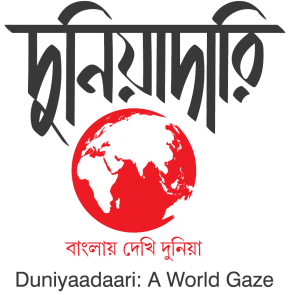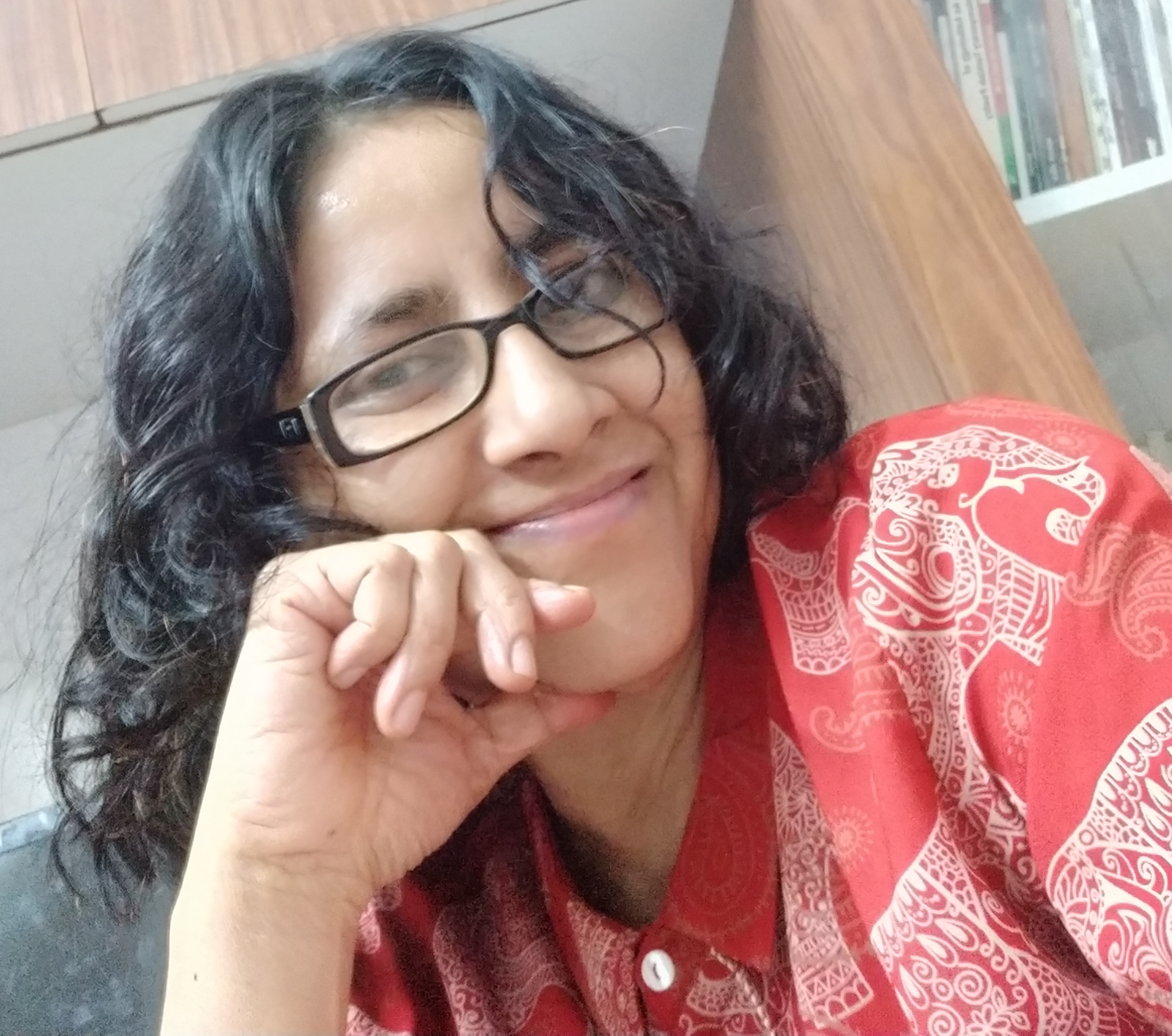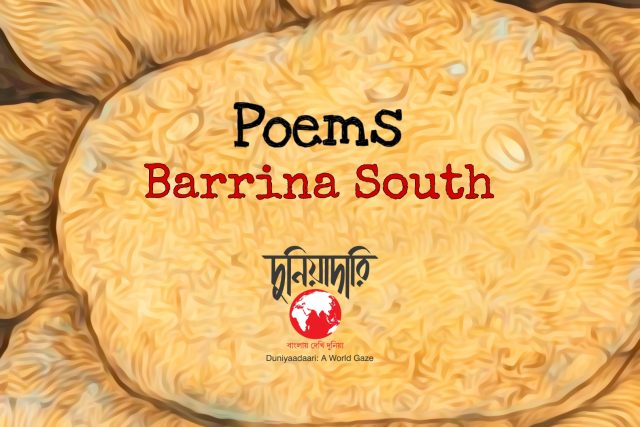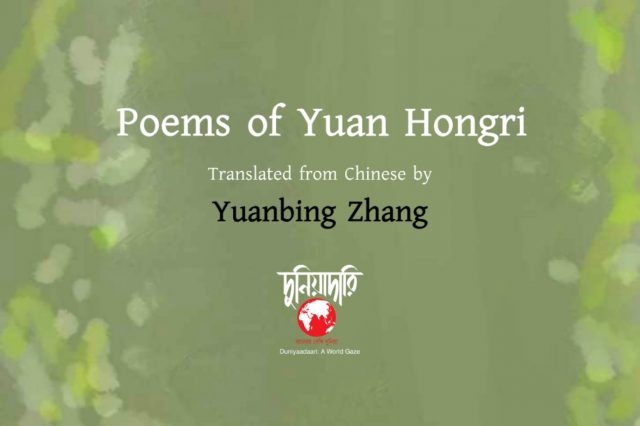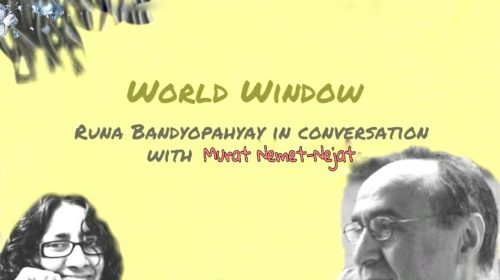
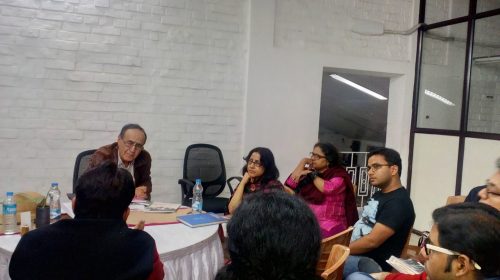
Murat Nemet-Nejat, a Turkish-American poet, essayist and translator. I met him first time during his reading session of his book length poem Animals of Dawn at Kolkata, organized by Kaurab in 2016. I was absolutely mesmerized by his reading. Words and sounds were engraving the architecture of animals, plants, speck of dust, dew of dawn with colour and without colour to transform Shakespeare’s Hamlet. It was a journey of a poet to search for the metaphor between void and non-void, real and unreal, living and un-living, sanity and insanity. A terrible disaster flashed on my earlier realization of Hamlet. A new feeling started vacillating at the confluence of appear-disappear myth. After that experience I became fascinated by his writings and tried to read all his books. I had various opportunities to meet him during his visits to Kolkata International Book Fair during 2018 and 2019 for his various readings organized in the book fair. We started our conversation with his poems “Io’s Song”, he was working with. I was surprised with one of his wonderful expressions like,
The secrets of a language’re hidden, in another language.
oh, tantra
tantra
the secret of my heart!
I asked him about the root of this “tantra” as it’s a Sanskrit word, meaning weaving, to imply the interweaving of tradition or teachings as threads into text/content/technique/practice etc. And also it means string to imply vibration/music/song. He gave his answer in a wonderful tone,
The dialectical connection between the western idea of “content” and the Indian “tantra” is an observation. This distinction is very important for my poetry (and myself). In the West, form (consequently content) is seen in terms of restrictions. Therefore, finally, form is seen as static and “eternal”; in that sense, as “changeless.” I want to liberate that static sense of content. Form becomes movement, process, change; in that sense, it becomes vibration, music as plucking of strings. Content becomes tantra. It is on that level that content exists in The Spiritual Life of Replicants, Animals of Dawn and Io’s Song. To my delight, it is those vibrations that you have responded in your reviews of my Animals of Dawn (for instance, in approaching my treatment of time) and in my other work. The same vibrations are occurring between us. That is the connection we feel between us, I think.
From this point of our conversation I approached him for an interview about his views on poetry and poetics he used in his writings. He agreed and hence the following interview started. I started with my very basic questions about poetry and poetics and then tried to know his experiments with language, his ideas about poetics, way of approaches to poetry and so on.
Runa Bandyopadhyay: What is poetry? I received various types of responses from various poets. I like to know your views about this.
Murat Nemet-Nejat: Poetry says what cannot be said otherwise. Each language, by its very grammar and ideologies, focuses on certain facts, developing a system of the real around them; while it suppresses other alternative avenues, making them basically unsayable or unreal and non-existent in that language. For me, the function of the poem is to tease out those suppressions, those “unreals.” They appear as glimmers at the peripheries of the language, essentially, where language begins to crack reaching its limits of expression. Those limits are the poem. In other words, for me, poetry has little to do with saying beautifully something already known or said. That is what art traditionally is assumed to be—the craft of reinforcing the accepted by beauty. That is not what I am after—beauty; rather, freeing suppressed thoughts and emotions.
R.B: What is the relation between poetry and poetics from your point of view?
M.N.N: My poetics describes the strategy, the process by which the poem attacks the language (in my case English) by forcing it to reveal some of its pregnant silences which, nevertheless, to use an expression from sciences, like dark matter bend, determine our lives. I start all my poems with a vague sense of direction and discover my way and its method as I write the poem, often during a number of months or years. Almost all my poetics essays were written after (not before) having finished the poem to which each applies and appears as an afterword in the poem. My poems evolve, change. As a result, the essay describing the poetics that built The Spiritual Life of Replicants (a poetics having to do with film, fragments and Eda) is different from the poetics of my next poem Animals of Dawn where the poetics has to do with textual commentary of holy texts and the idea of poem as an ideogram. I am sure the new poem I am writing now Io’s Song will have its own poetics. Nevertheless, certain overarching ideas unite them. They have to do with Eda.
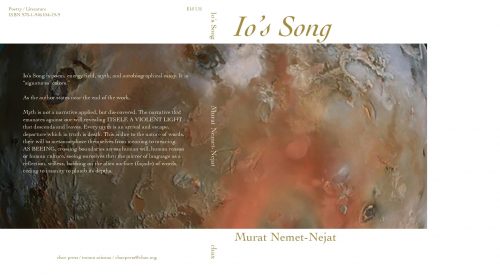 R.B: Coming back to your latest experiment of poetry with “Io’s Song”. The sound “Io” is an expression of some feelings – is used in which language? As I know in Telegu, a south Indian language, also use this sound of expression to imply amazement/shock/surprise.
R.B: Coming back to your latest experiment of poetry with “Io’s Song”. The sound “Io” is an expression of some feelings – is used in which language? As I know in Telegu, a south Indian language, also use this sound of expression to imply amazement/shock/surprise.
M.N.N. I assume you mean the sound of “Io”, Yes, this sound constantly alters and is transformed in this poem. That’s how Io’s Song expands, moves from one fragment (poem) to another. It is the name of the nymph attacked by Zeus in Greek and in English. As “ion”, it refers to excess (or lack, + or -) of electrons in a molecule, the profound differences that excess or lack implies. Split, “Io” also becomes “I” (the person) and “O” (cry of desire or pain), etc., etc. These shifting sounds will also permeate the final section of the poem, I think.
R.B: I noticed in your book length poem Animals of Dawn that despite being an American poet, you didn’t write poems directly in the American language. You have made the accented American language to conceive the soul of unaccented Turkish language, what you call cracks or imperfections in the accentual rhythms of American language. Could you please elaborate the process of making this cracked American language as a tool in your poetry?
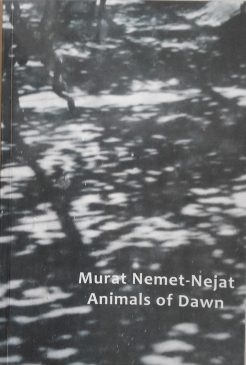 M.N.N: The key to this cracked American language is that I have the courage to let my instincts (in essence my soul) lead the language I am using, without being afraid if the language is grammatically correct or not or if it fits within the standards of accepted poetry. One cannot “create” an accent, which is the photographic image in words of who one is. For instance, I am a middle eastern Jew, deeply entangled in Western philosophy and literature, etc., simultaneously very suspicious of the simplistic, often self-sufficient, technology-based answers it has provided for the last three hundred years or so. I yearn for what they disregard and are forced to dismiss, what is outside their field of expression. For me, Eda is a linguistic vision of what they miss, a contra, an alternative challenge to it, a door to new possibilities. Twentieth century Turkish poetry is a vision of contrary, innocent, non-ironic language embodying, in ecstatic fullness, that yearning.
M.N.N: The key to this cracked American language is that I have the courage to let my instincts (in essence my soul) lead the language I am using, without being afraid if the language is grammatically correct or not or if it fits within the standards of accepted poetry. One cannot “create” an accent, which is the photographic image in words of who one is. For instance, I am a middle eastern Jew, deeply entangled in Western philosophy and literature, etc., simultaneously very suspicious of the simplistic, often self-sufficient, technology-based answers it has provided for the last three hundred years or so. I yearn for what they disregard and are forced to dismiss, what is outside their field of expression. For me, Eda is a linguistic vision of what they miss, a contra, an alternative challenge to it, a door to new possibilities. Twentieth century Turkish poetry is a vision of contrary, innocent, non-ironic language embodying, in ecstatic fullness, that yearning.
In other words, rather than a technique or method of writing, accent is a fidelity to who one is and the courage to follow it. When “Questions of Accent” was first published in The Exquisite Corpse, the American poet Benjamin Friedlander in a letter he wrote defending the essay against Clayton Eshelman who led the attack against it, said the most important thing he learnt from my essay was that, “one cannot hear one’s accent”; one just speaks it. Having an accent involves the “inability” to hear it, making “correcting” it impossible.
R.B: During my journey through your Animals of Dawn, I was hooked on your idea of horizontality of time. According to you time is defined by attention, not by memory, because memory is deceptive, therefore vertical. But attention has only intensity and duration, so horizontal. I was debugging this definition of time. At that moment a second question triggered me – Why Hamlet is the subject of it? Why not the other plays of Shakespeare? As I realized by thorough reading that the answer lies in the above definition of time. Hamlet is an act where time and consciousness play the major role throughout the act. Compression of time is a general characteristic of any play. Hamlet achieved this not by concurrence of events but by a time gap, inserted as a significant duration. During this duration hamlet’s attitude towards time has changed. Apparently the movement of Hamlet may be in same pace with Claudius but his consciousness of duration makes him aware about his slowness. But these are all my thoughts. Since I am lucky to have a chance to talk to you directly, I like to know your views about this implantation of duration in Animals of Dawn.
M.N.N: In Hamlet time is not compressed, as usual; but delayed. Because of that memory—including the audience’s—loses its continuum, a sense of time as the past; but becomes discontinuous, unmoored, only existing as “points” of attention, in other words, time becomes one with consciousness. Otherwise remains unknown, a mystery (in another sense, oblivion, death). To me, that is the great mystery, power, ultimately beauty of Shakespeare’s play—opens the door for a new dimension, or toward a new state of consciousness.
R.B: I am always fascinated with your translation of Turkish poems into American English. When I started reading your most famous and controversial anthology, Eda: An Anthology of Contemporary Turkish Poetry, I was searching for the poetics, named as “Eda” which is, according to you, stands for the essence of all the authentic hallmarks of Turkish culture and poetry. In your essay in the book, “the idea of a book” you added Walter Benjamin’s comments on translation from his essay The Task of the Translator, “what gives a language translatability is its distance from the host language. Eda is this distance”. I like to know more about this wonderful poetics from you.
M.N.N: What Walter Benjamin in essence means by “what gives a language translatability is its distance from the host language” is that the real purpose of a translation is not to create a beautiful poem that fits it like a glove in the target language; but to create cracks, mismatches in it so that it renders sayable what has been previously silenced in it. These alien, distant sounds (or meanings) appear only in the peripheries of that language, as “tangents.” In that respect, Benjamin’s view of translation echoes the concept of a poem that I expressed in my previous response. In “The Task of the Translator” Benjamin compares a translation to a “broken vase” that is made of fragments patched together imperfectly, only tangentially relating to the target language, always remaining in its peripheries. One can see that my poetics of fragment as a poetics unit that I discuss in “A Few Thoughts On Fragments” (the afterward to The Spiritual Life of Replicants) also echoes Benjamin’s idea of translation. “The Task of the Translator” is one of the most radical and profound essays written, not only on translation; but on poetry and language itself. Those too bound by tradition have difficulty understanding it, particularly its last part when Benjamin talks about “ideal language.” As a result, they call the essay “mystical” or “poetic” which, in Western parlance, means unserious, deluded, to be dispensed with. I talk more about this in my 1991 essay “Translation and Style” http://www.cs.rpi.edu/~sibel/poetry/murat_nemet_nejat.html
 R.B: The Sufism is in the heart of your book The Spiritual Life of Replicants. As you mentioned in your Eda: An Anthology of Contemporary Turkish Poetry, which revealed your Sufism as, “The supreme Sufi act is weeping, the dissolution of the individual ego by suffering through love, loss, the liquid of tears.” Yes, this Sufism is known to me, it is in the core of Indian/Bengali culture/tradition/language. In your book The Spiritual Life of Replicants, a spiritual filmic language could be realized by the movement of eye through the pages of your poems. Is this Sufism inbuilt in the agglutinative Turkish language? Are you trying to infuse this Sufism of Turkish language into the accented American language?
R.B: The Sufism is in the heart of your book The Spiritual Life of Replicants. As you mentioned in your Eda: An Anthology of Contemporary Turkish Poetry, which revealed your Sufism as, “The supreme Sufi act is weeping, the dissolution of the individual ego by suffering through love, loss, the liquid of tears.” Yes, this Sufism is known to me, it is in the core of Indian/Bengali culture/tradition/language. In your book The Spiritual Life of Replicants, a spiritual filmic language could be realized by the movement of eye through the pages of your poems. Is this Sufism inbuilt in the agglutinative Turkish language? Are you trying to infuse this Sufism of Turkish language into the accented American language?
M.N.N: The answer is yes to both your questions. The pre-Islamic origins of Sufism is in central Asian Shamanism. Islam gives an intellectual structure to it, basically through the concept of “the arcs of ascent and descent”; it tries to tame it. Nevertheless, Sufism represents a subversive strain in Islam, through drinking of wine, eroticism, homo-sexuality, etc., which are surviving traces from its pagan, Shamanistic origins. Shamanism represents an animistic culture where the split between the objective and subjective does not exist, each is defined by the other; both are equally real and continuously bleed into and shape each other. Turkish is a central Asian language also, embodying the same animistic view of reality. Its agglutinative syntax is the perfect vehicle for a world view of continuous becoming, as I say in the intro to Eda anthology, a “language of emerging affections,” where the object/ive (the sky/the other) continuously merges with the subject/ive (the robot eye/I). As you so beautifully observed, discussing the poem “photons escaped” in The Spiritual Life of Replicants, at its heart that poem attacks the Cartesian split between the body (a machine) and the soul (the forbidden human territory banished from science to religion and poetry) and reverses it. In the poem. the human and the android belong to one continuum. The poem starts with the question: to what extent is the android almost human (the Turing Test)? By the end, the answer becomes almost a reversal, itself a question: is the human finally almost no different than an android? Do they not merge? In Blade Runner (the movie on which the poem is based) everyone dies at the end. Everyone is an android.
Runa, it seems, modern physics—you are a molecular scientist, not I—is more akin to a shamananimistic view of reality than to the Cartesian image of the world: “I exist because Eye may not exist; therefore, I am.”
R.B: During the translation period from your book The Spiritual Life of Replicants, I was logged in to your poem “Photons Escaped”,
The perennial illusion is that the body is mortal, the soul immortal. The truth is that the body is immortal, endlessly involved in transformation, into dust, into humus, into water, into food chains….into star dust. What ceases to exist is that the eye experiencing these transformations, the mind’s eye, the soul, which is too too mortal, less durable than as electron.
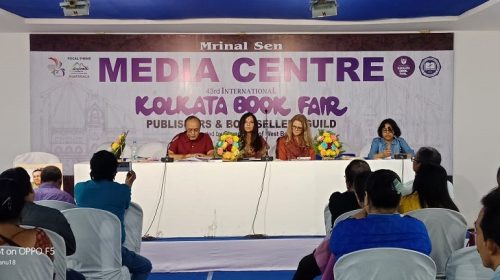 From the word point of view, it looks as if it’s an inversion of Christine doctrine. Yet when I see this poem from my science balcony, the name of the poem “Photons Escaped” becomes the essence of the illusion made by you. The definition of photon, as an elementary particle itself, is directing me towards the consciousness. Again the photon has zero rest mass and is always moving at the speed of light and exhibit wave–particle duality. This dualism of matter and consciousness leads my thought towards the ancient Hindu Vedic philosophy. Since you are present here for direct conversation, I don’t like to miss my opportunity to ask you more about the interaction of “eye/soul” and “I/body”, which merges in an open-ended weave of your language.
From the word point of view, it looks as if it’s an inversion of Christine doctrine. Yet when I see this poem from my science balcony, the name of the poem “Photons Escaped” becomes the essence of the illusion made by you. The definition of photon, as an elementary particle itself, is directing me towards the consciousness. Again the photon has zero rest mass and is always moving at the speed of light and exhibit wave–particle duality. This dualism of matter and consciousness leads my thought towards the ancient Hindu Vedic philosophy. Since you are present here for direct conversation, I don’t like to miss my opportunity to ask you more about the interaction of “eye/soul” and “I/body”, which merges in an open-ended weave of your language.
M.N.N: Your question here, Runa, segues well from my response to a previous question of yours. Philosophically, in my view, the most radical thing in The Spiritual Life of Replicants is that I equate the soul with consciousness. Consciousness is that aspect of the soul that seems most “real,” attached most closely to “objective” reality. As Godard says in “Luc Godard Speaking Directly in Masculin Feminin” in The Spiritual Life of Replicants, “Yes, in a way we are the centre of the world—we speak with our lips, we see with our eyes, we think with our thoughts.” Photons, on the other hand, represent that limit of reality that is elusive and “almost non-existing,” “zero mass moving at the speed of light.” They constitute a vector towards a zero where the “real” becomes “unreal” and the “unreal” “real.” They merge, as photons, in the interactions of “eye/soul” and “I/body” in the “open-ended weave” (as photons do) of the poem.
R.B: When I was reading your book on photography, The Peripheral Space of Photography, I felt that you are searching for the language of the photographic medium, which is also a medium of art. The central character of Photography carries blurriness of circumference, play of light in the aperture, its duration. These cracks/imperfections, hanging in the focal point of photography, speaks about its fairy tale. And here’s where you want to find the ‘in between lines’, hanging between words and pictures, between its shadow and darkness, from which the union of poetic-language and photographic-language begins. I like to know how this infused language helped you in the construction process of your poetry.
M.N.N: What photography taught me is a process of thinking by looking. When thought involves the eye, it exists as motion, a wave/tissue of thought, rather than subject/predicate statements that freeze thought into pronouncements, into “is” and “is not.” At its birth in the 19th century, photographic camera/lens was slow and cumbersome. In the registration of the image, through the transfer of light on the material plate, all sorts of mistakes occurred, despite the photographer’s best efforts. Looking first at these 19th century photographs, I realized the mistakes were very often more interesting than what the photographer focused on. Looking at these photographs involved me in a meditation on time where both the viewer (in this case, myself) and the subject (everything in front of the lens, human or non-human) became liberated from the frame of the photographer. The “focused” field of the photographic space (shaped by the photographer, his or her supposed authority) turned into a flat field of freely interacting thought, a dialectic dialogue, between the past and present—a flatness very reminiscent of the space in which photons move in The Spiritual Life of Replicants. Most of the dislocations in my poetry, either in the break-down of words and syllables or in the tangential, often jarring juxtaposition of fragments in my late poetry of the last twenty-five years are attempts to recreate in poetry the dislocation between the authority of the photographer and the freedom of, not only who but also what is being photographed; also of the freedom of the viewer (and in my poetry of the reader) these 19th century photographs evoked. The purpose of this style, this poetics is to undermine any authority based on power and social (therefore, intellectual) privilege, toward a new kind of consciousness fore-fronting the weak, politically the “non-existing,” the have-not.
R.B: During the process of transcreation project in 2018, “Bridgeable Lines: An Anthology of Borderless World Poetry in Bengali, with 12 American contemporary poets including you, I had a confusion about the concept/belief that whether translation is an auxiliary activity to literature or an independent genre. I am blessed to receive your wonderful gift, The House That Jack Built, edited by Peter Gizzi. Through the reading of the book, I could realize the phrase “against the grain”, you used in the introduction of my new book Nocturnal Whistle, as “the distance the poem has to “cross” is linguistic, which it does through a writing “against the grain”, (a phrase used by the American poet Jack Spicer to describe how he records poetic radio communications he receives from Mars)”. In your talk, Translation: Contemplating Against the Grain, (A Talk on Walter Benjamin given at Stevens Institute in 1999) published in magazine (https://www.cipherjournal.com/html/nemet-nejat_spicer.html) you were comparing two works on translation, Walter Benjamin’s The Task of the Translator and Jack Spicer’s poem essay After Lorca, to conceive translation as the anarchic poetic form of your time. It will be a wonderful experience for me to listen from you, how you view Benjamin’s “literalness” with Jack Spicer’s “present”, in his dictation process, of writing against the grain or Benjamin’s “translatability” and message from the Spicerean outer, Translation is an intensification—not a bridging—of distance.
M.N.N: I have read “The Task of the Translator,” in intervals, multiple, multiple times over the years. Every time I discovered something I had missed or failed to realize the importance of and dismissed as being woolly-headed or irrelevant to my endeavours, or originally misunderstood, or simply not understood at all. “Literalness” is a word that has both troubled and arrested me for years. The obvious difficulty is that “literalness” seems to contradict what Benjamin says in another part of the essay: that words in each language is trapped within “the modes of its intention.” “Brot” in German does not mean “bread” in English.” If so, what is the point of “literalness”? Does it not lead to an “incorrect” translation? In my essay “Translation: Contemplating Against the Grain” I try to unpack the thrilling and disruptive depth of this contradiction, which I felt needed to be faced, and its relation to Spicer. My attempt to answer the question led to a new kind of poetics my essay proposes:
Translating words “literally” from a language, one breaks down, disrupts the integrity and authority of its modes of intention, opening it up. Simultaneously, since the modes of intentions of the target language are different, that literalness breaks down the integrity of the target language also, opening it up also; in the latter the break-down is experienced as “distance,” as “the other” (as Mars). In this kind of translation both languages are liberated from the authority of their modes of intentions, merging/synthesizing in a third space which Benjamin calls “ideal language.” All languages reveal their suppressed potentials there; which Benjamin calls their intentio (deep potential purpose). In such a translation, the movement is not a one-dimensional crossing from A to B; rather both A and B, bound in their own modes of intention, move to a third place C (the space of ideal language). Such a translation/(poem) remains on the peripheries of both languages. As “distance,” it points to something new, alien in the target language, previously either “non-existent”/or “veiled” in it. Often misreading, deforming or altering the semantic and other usages of an original word, it liberates it from its conventional modes of intention, revealing its suppressed or forgotten history, and all the potential meanings to come of that language.
“Literalness” means “anti the modes of intention of that language.” It involves a process of revelation, of “hearing the silent.” That is the startling meaning of Benjamin’s paradoxical statement.
Spicer’s writing against the grain (“writing in the present”) also is an attempt to free the poet/translator (for instance, the poet of After Lorca who exchanges letters with a dead Lorca) from the literary conventions (“furniture on the deck”) of his or her culture, going against its modes of intention. That is why he says that, the “dictations” (almost beyond his/her control) a poet receives “writing in the present” arrive from Mars. Isn’t every language, bound inside its modes of intention, a Mars to another bound inside its own?
A translation is receiving (and decoding) “radio communications” from Mars. That is how “literalness” becomes writing against the grain. The disruption the process necessarily involves makes translation (or poetry echoing the form, recording of silence, its mysteries) the anarchic genre of our time.
R.B: What is the relationship among texts –– through appropriations or translations or (re)(de)constructions, etc. –– in poetry? When a poem triggers a reader and the latter assimilates the original poem into her/his own vision, can s/he rewrite it through expansion or commentary or meta-poems, etc., yet always retaining the original inside itself? What is your attitude toward “ownership” of a poem? What is an original poem?
M.N.N: Yes, I think so. One way or another, each poet feeds on other poets and poems, other texts. A poem is not owned by the poet who writes it, but belongs to its readers and re-users also. Each reading (or re-use) slightly changes the text. This is not a sign of the text’s weakness or the reader’s lack of objectivity or the re-user’s theft. To the contrary, it is a proof of the text’s richness, the potential meanings inherent in it. A good, sensitive reader of a poem (the re-user is a reader also) is in touch with these multi-directional potentials in it. Therefore, every good reading alters, redirects, expands—for that very moment, and ever after—the text. These readings constitute the poem, which alters as read through time. The Turkish poet Seyhan Erōzçelik said, “my poems are like my children. Once out in the world, they are on their own.”
The meta-poetry you are describing—through the assimilation, commentary on, expansion of, etc., another poem, in my opinion, is possible. Animals of Dawn maybe be regarded as a meta-poem, basically derived as commentaries on and meta-happenings from the first two acts of Hamlet.
Murat Nemet-Nejat:
 Poet, Essayist and Translator Murat Nemet-Nejat is a Jewish American. Breaking down the mainstream tradition of Western poetry, he started a new poetics in his own way. Though he was born in Istanbul, Murat is a Persian Jew. He grew up in Turkey and studied literature at Amherst College and Columbia University in USA and an American citizen since 1959. His mental adaptation has been made with the blending of different cultures of his miscellaneous position. Murat Nemet-Nejat is the author of several books of poetry like The Bridge (Martin Brian and Okafi, London, 1977), The Spiritual Life of Replicants (Talisman, 2011), Structure of Escape, Animals of Dawn (Talisman, 2016) and most recently IO’s Song (Chax Press, 2019). He is not only a poet but also a translator from Turkish to American English. includes poetry of Turkish poets: Coffee Grinds (Talisman, 2010), Ece Ayhan’s Blind Cat Black and Orthodoxies (Los Angeles: Sun & Moon Press, 1997), Orhan Veli’s I, Orhan Veli (New York: Hanging Loose Press, 1989). He is the editor and translator of Eda: An Anthology of Contemporary Turkish Poetry (Talisman, 2016) and most recently Birhan Keskin’s Y’OL (Spuyien Duyvil:New York City, 2018).
Poet, Essayist and Translator Murat Nemet-Nejat is a Jewish American. Breaking down the mainstream tradition of Western poetry, he started a new poetics in his own way. Though he was born in Istanbul, Murat is a Persian Jew. He grew up in Turkey and studied literature at Amherst College and Columbia University in USA and an American citizen since 1959. His mental adaptation has been made with the blending of different cultures of his miscellaneous position. Murat Nemet-Nejat is the author of several books of poetry like The Bridge (Martin Brian and Okafi, London, 1977), The Spiritual Life of Replicants (Talisman, 2011), Structure of Escape, Animals of Dawn (Talisman, 2016) and most recently IO’s Song (Chax Press, 2019). He is not only a poet but also a translator from Turkish to American English. includes poetry of Turkish poets: Coffee Grinds (Talisman, 2010), Ece Ayhan’s Blind Cat Black and Orthodoxies (Los Angeles: Sun & Moon Press, 1997), Orhan Veli’s I, Orhan Veli (New York: Hanging Loose Press, 1989). He is the editor and translator of Eda: An Anthology of Contemporary Turkish Poetry (Talisman, 2016) and most recently Birhan Keskin’s Y’OL (Spuyien Duyvil:New York City, 2018).
